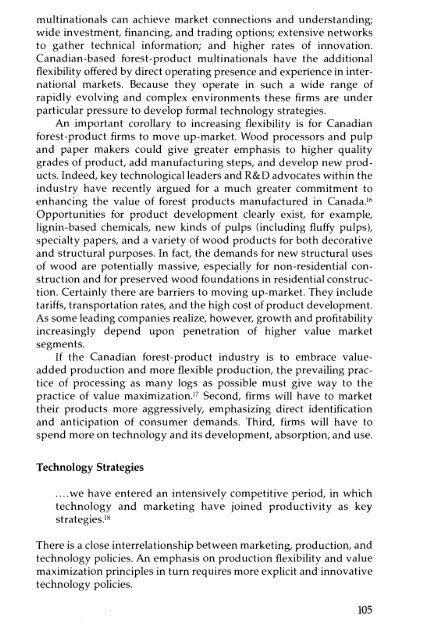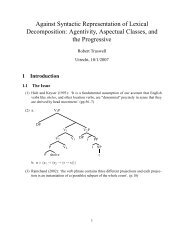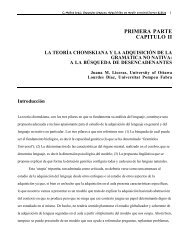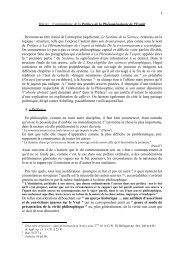<strong>the</strong> concept of flexibility explicit in <strong>the</strong>ir investment plans, <strong>and</strong> toconsider a wider range of technological choices.A firm's "flexibility" is judged by how easily it adapts its geographicscope <strong>and</strong> strategy, internal structure, product design, productiontechniques, <strong>and</strong> design of industrial systems to changes, oranticipated changes, in market dem<strong>and</strong>s. Flexibility may be a characteristicof a specific mill or of <strong>the</strong> firm as a whole. Investment inin-house R&D is an attempt to promote <strong>the</strong> flexibility of <strong>the</strong> wholefirm. As corporate environments become more dynamic, firms need todevelop broadly based flexibility with more diverse products <strong>and</strong>proportionately more liquidity."How firms enhance <strong>the</strong>ir flexibility to meet changing marketneeds depends upon particular circumstances. During <strong>the</strong> 1950s <strong>and</strong>1960s several west coast firms improved flexibility by concentratinglumber, plywood, <strong>and</strong> pulp <strong>and</strong> paper operations on one site <strong>the</strong>rebyproviding for easy diversion of raw materials from one end use toano<strong>the</strong>r, as well as allowing for considerable cost savings, for example,in <strong>the</strong> use of energy. Those integrated facilities located on tide-wateralso enjoyed access to diverse markets <strong>and</strong> sources of timber.'? O<strong>the</strong>rmore specialized factories may be able to sell to new geographicalmarkets <strong>and</strong>/or differentiate <strong>the</strong>ir product by introducing more versatiletechnology. Sawmills, for example, can potentially manufacturelumber, pulp chips, particleboard furnish, energy, specialty products(for example, sawdust for cattle feed) <strong>and</strong> thus generate multiple cashflows. If <strong>the</strong>y are integrated with pulp <strong>and</strong> paper making processes aspart of forest-product complexes, <strong>the</strong>y can bring toge<strong>the</strong>r a variety ofengineering <strong>and</strong> technical skills <strong>and</strong> provide a focus for a variety ofinnovations.P Ano<strong>the</strong>r way firms can achieve flexibility is byinvesting in specialty mills.'!For <strong>the</strong> firm, "horizontal <strong>and</strong> vertical" diversification into newproducts for existing markets <strong>and</strong> new products made with old equipmentextends <strong>the</strong> range of forest-products that can be manufacturedfrom a given resource base <strong>and</strong> increases flexibility by permittingcounter-cyclical revenue generation. If <strong>the</strong> opportunity costs of"related," if non-conventional, forest-products, such as chemicals <strong>and</strong>energy, increase rapidly, firms will be tempted to invest in <strong>the</strong>seactivities. In this regard, <strong>the</strong> extent to which <strong>the</strong> firm can diversify itsuse of <strong>the</strong> forest resource is partly determined by its technologicalcapability. Similarly, such a strategy would exercise a firm's technologicalresources <strong>and</strong> in turn would enhance <strong>the</strong> range of potentiallyrelevant innovations available to <strong>the</strong> firm.How firms become flexible also depends on <strong>the</strong>ir size." Smallfirms can develop fast response to markets, high internal efficiency,<strong>and</strong> service to specialized market niches. In contrast, <strong>Canadian</strong>-based104
multinationals can achieve market connections <strong>and</strong> underst<strong>and</strong>ing;wide investment, financing, <strong>and</strong> trading options; extensive networksto ga<strong>the</strong>r technical information; <strong>and</strong> higher rates of innovation.<strong>Canadian</strong>-based forest-product multinationals have <strong>the</strong> additionalflexibility offered by direct operating presence <strong>and</strong> experience in internationalmarkets. Because <strong>the</strong>y operate in such a wide range ofrapidly evolving <strong>and</strong> complex environments <strong>the</strong>se firms are underparticular pressure to develop formal technology strategies.An important corollary to increasing flexibility is for <strong>Canadian</strong>forest-product firms to move up-market. Wood processors <strong>and</strong> pulp<strong>and</strong> paper makers could give greater emphasis to higher qualitygrades of product, add manufacturing steps, <strong>and</strong> develop new products.Indeed, key technological leaders <strong>and</strong> R&D advocates within <strong>the</strong>industry have recently argued for a much greater commitment toenhancing <strong>the</strong> value of forest products manufactured in Canada."Opportunities for product development clearly exist, for example,lignin-based chemicals, new kinds of pulps (including fluffy pulps),specialty papers, <strong>and</strong> a variety of wood products for both decorative<strong>and</strong> structural purposes. In fact, <strong>the</strong> dem<strong>and</strong>s for new structural usesof wood are potentially massive, especially for non-residential construction<strong>and</strong> for preserved wood foundations in residential construction.Certainly <strong>the</strong>re are barriers to moving up-market. They includetariffs, transportation rates, <strong>and</strong> <strong>the</strong> high cost of product development.As some leading companies realize, however, growth <strong>and</strong> profitabilityincreasingly depend upon penetration of higher value marketsegments.If <strong>the</strong> <strong>Canadian</strong> forest-product industry is to embrace valueaddedproduction <strong>and</strong> more flexible production, <strong>the</strong> prevailing practiceof processing as many logs as possible must give way to <strong>the</strong>practice of value maximization." Second, firms will have to market<strong>the</strong>ir products more aggressively, emphasizing direct identification<strong>and</strong> anticipation of consumer dem<strong>and</strong>s. Third, firms will have tospend more on technology <strong>and</strong> its development, absorption, <strong>and</strong> use.<strong>Technology</strong> Strategies....we have entered an intensively competitive period, in whichtechnology <strong>and</strong> marketing have joined productivity as keystrategies."There is a close interrelationship between marketing, production, <strong>and</strong>technology policies. An emphasis on production flexibility <strong>and</strong> valuemaximization principles in turn requires more explicit <strong>and</strong> innovativetechnology policies.105
- Page 3 and 4:
Science Council of Canada100 Metcal
- Page 5 and 6:
ContentsForewordAcknowledgments1113
- Page 7 and 8:
In-House R&D by Equipment Suppliers
- Page 9 and 10:
Table 2.5: R&D Employment in 10 Can
- Page 11 and 12:
ForewordTechnological innovation an
- Page 14 and 15:
adapted sufficiently rapidly to the
- Page 16 and 17:
Finally, the author interviewed sen
- Page 18 and 19:
Table 1.3: Degree of Foreign Contro
- Page 20 and 21:
Figure 1.1: Innovation Patterns and
- Page 22 and 23:
Since 1945 the pace of technologica
- Page 24 and 25:
Toward Reliance on Research rather
- Page 26 and 27:
science occurred between 1900 and 1
- Page 28 and 29:
Forestry Sector R&D SystemIn Canada
- Page 30 and 31:
up its forestry research group at N
- Page 32 and 33:
and one other that was strongly ori
- Page 34 and 35:
closely involved in the establishme
- Page 36 and 37:
to vet and control research priorit
- Page 38 and 39:
In-House R&D by Equipment Suppliers
- Page 40 and 41:
product. One, by no means atypical,
- Page 42 and 43:
only internal source of dissolving
- Page 44 and 45:
of which only 18 per cent came from
- Page 46 and 47:
New information can be generated by
- Page 48 and 49:
Chapter 3The R&D System andHow It W
- Page 50 and 51:
Table 3.2: Summary Characteristics
- Page 52 and 53: Sixteen firms provided details on s
- Page 54 and 55: The Opco Process: A Case Study of I
- Page 56 and 57: however, within the last two decade
- Page 58 and 59: in 1959, and a full-scale experimen
- Page 60 and 61: Papritection was developed as follo
- Page 62 and 63: Further tests were conducted in 198
- Page 64 and 65: fully automatic machines, and its s
- Page 66 and 67: Chapter 4Technological Capability a
- Page 68 and 69: Table 4.2 provides measurements of
- Page 70 and 71: forest-product equipment patents, w
- Page 72 and 73: Foreign-Ownership and In-House R&DT
- Page 74 and 75: Technological Liaisons: Forest-Prod
- Page 76 and 77: for this deficiency the federal gov
- Page 78 and 79: On the other hand, three of the lea
- Page 80 and 81: one of Sweden's forest-products gia
- Page 82 and 83: Capital Investments in the Canadian
- Page 84 and 85: and Quebec accounted for 33.9 per c
- Page 86 and 87: Table 5.5: Canadian Forest-Product
- Page 88 and 89: Scandinavian manufacturers are in t
- Page 90 and 91: was implemented smoothly and manage
- Page 92 and 93: the foundations were poured, until
- Page 94 and 95: inherent capabilities were never fu
- Page 96 and 97: especially in the east, has receive
- Page 98 and 99: "export staples mentality." The bel
- Page 100 and 101: size of the conglomerates would cer
- Page 104 and 105: This author therefore recommends th
- Page 106 and 107: with respect to technology transfer
- Page 108 and 109: of the R&D system and influence the
- Page 110 and 111: operations, attitudes toward innova
- Page 112 and 113: limited R&D base, but they do empha
- Page 114 and 115: The small size and non-innovative n
- Page 116 and 117: Promoting In-House R&D in the Fores
- Page 118 and 119: Notes1. The Technological Challenge
- Page 120 and 121: 7. For example, nj. Daly, "Weak Lin
- Page 122 and 123: 7. P.G. Mellgren and E. Heidersdorf
- Page 124 and 125: this R&D facility has become even s
- Page 126 and 127: 3. K. Noble, "Forest Industry Urged
- Page 128 and 129: Publications of the ScienceCouncil
- Page 130 and 131: Reports on Matters Referred by the
- Page 132 and 133: No. 40. Government Regulation of th
- Page 134 and 135: 1981An Engineer's View of Science E
















